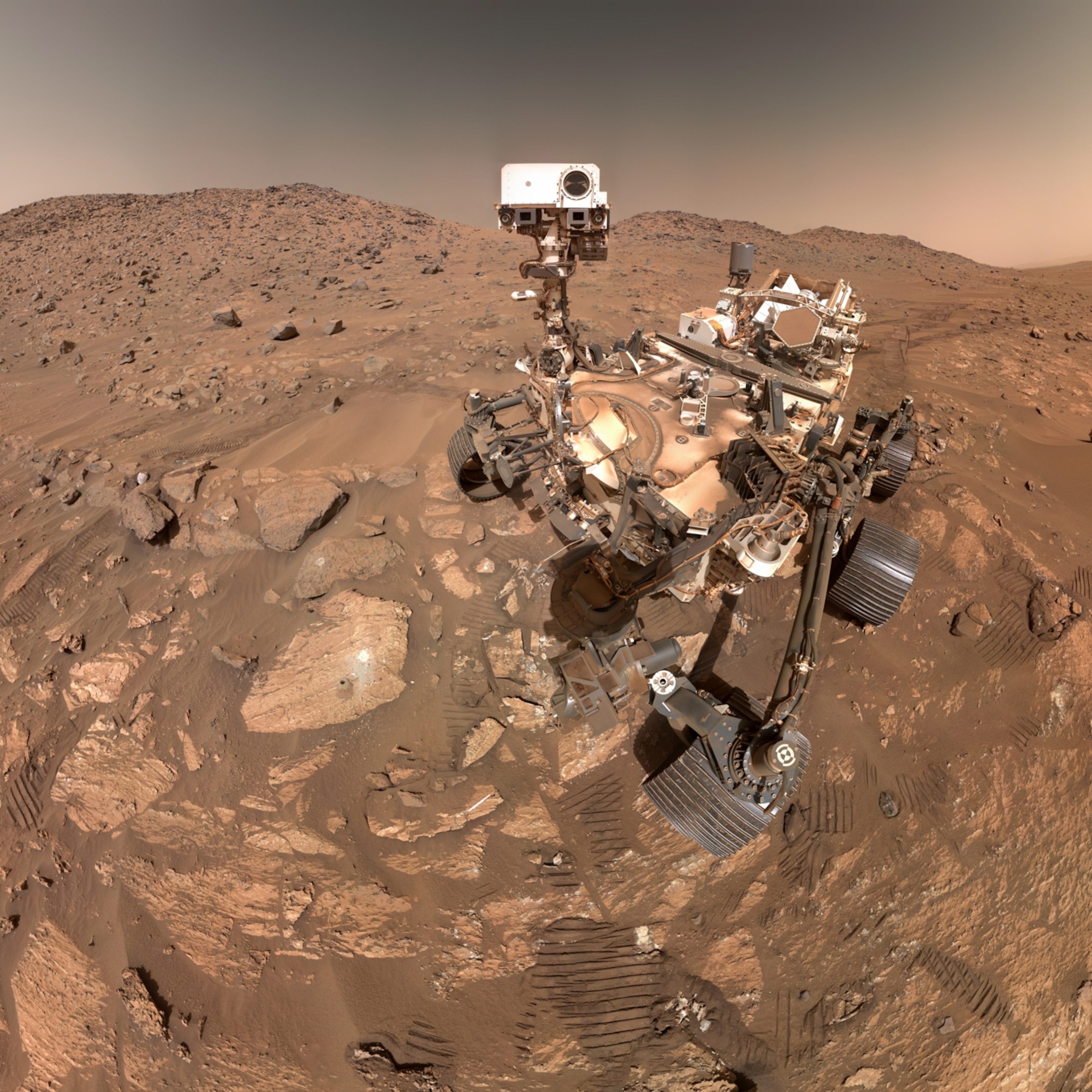
Deep Water May Have Surrounded Ancient Mars Mountain
A giant lake could have filled Gale Crater and encircled Mount Sharp.
Water-carved rocks high up on a Martian mountain, just reported by planetary scientists, point to a very watery past for the red planet.
The new finding comes from Gale Crater, where NASA's Curiosity rover landed in 2012. The rover has already discovered the remains of ancient streams and ponds there. (See "Six Cool Takeaways From NASA's Curiosity Rover.")
NASA has long looked for signs of past water on Mars, as evidence of conditions that perhaps supported life there billions of years ago. Whether the bone-dry landscape of Gale Crater was once quite wet, and maybe even home to a giant lake, has remained controversial.
Now, new research into an unusual series of gridlike rock formations high up on Mount Sharp—an 18,000-foot (5,486-meter) mound in the middle of Gale Crater—is making an ancient lake there look more likely.
Known to scientists as "boxwork," the distinctive geometric patterns of the gridded rocks were cemented by significant amount of water during their formation. Yet they were found about a kilometer (0.6 miles) up the mountain from the crater floor.
"A boxwork like this needs water seeping into cement sediments in hard rock," said Kirsten Siebach of the California Institute of Technology, lead author of the discovery study published in the Journal of Geological Research: Planets. "It's a signature of how much water was once present across that layer."
Her co-author, Curiosity project scientist John Grotzinger, said he was surprised that the boxwork terrain was found at such a high elevation.
Grotzinger said the new work also supports an earlier key finding that minerals that can be formed only in the presence of water are found at the base of Mount Sharp. "This new observation ... [is] indicating that water was involved hundreds of meters above the base," he said.
Follow the Water
Mars scientists are always on the lookout for evidence of water on early Mars because of its essential role in the origin and survival of possible life.
While reaching the boxwork terrain would be a stretch for the rover and would take years, team members say it is a plausible and tempting science target if the rolling chemistry lab holds together several more years.
NASA's orbiting satellites spotted the boxwork formations in 2008, and they were photographed with increasing precision by the agency's orbiting HiRISE camera in ensuing years. As scientists study the structure and chemical composition of the boxwork, its importance has only grown.
Evocative of the ruins of an ancient city when viewed from above, the boxwork is intermittently visible over a range of 6 to 9 miles (10 to 15 kilometers).
But scientists say the exposed fretwork is most likely only a hint of what else remains covered by the mountain at the same level. Given the geological dynamics that create a boxwork, they say, similar formations were no doubt laid down during the same period, more than three billion years ago.
Similar formations are present on Earth, including large grids in southern Texas and the much-admired miniature boxwork at Wind Cave National Park in South Dakota. Two related boxwork formations similar to those on Mount Sharp have also been identified elsewhere on Mars.
Boxwork Bake-off
As Siebach explained it, the unmistakable rock structures are formed in a predictable way:
The original, relatively soft rock on Mount Sharp would have fractured under the weight of the rock above it. Briny water laden with minerals later seeped in and left deposits that were turned into rock, probably under the pressure of deep freezes. This rock was substantially harder than the original sedimentary deposits.
Over ensuing eons, the softer rock was eroded away by wind, leaving the telltale remains of stronger, more wind-resistant rock. In theory, many more kilometers of boxwork should be exposed in the millennia ahead as more of the mountain is eroded.
It remains unclear precisely how the water got into the rock at such a high level. Siebach said it could have come from rain even higher up, which would have seeped down to lower, flat portions of the mound.
Or the water could have come from soggy sediments or even a lake that filled the 96-mile-wide (154-kilometer-wide) Gale Crater more than three billion years ago.
The kilometer-high boxwork layer of today's Mount Sharp would have then been a relative low point in the crater where water might pool and then drain into the softer rock.
Using calculations for how much mineral-rich water is needed to make cement, Seibach and Grotzinger calculated that each square kilometer of exposed boxwork needed a minimum of 0.4 cubic kilometers (0.1 cubic miles) of water to form. Spread around Mount Sharp, that would translate to roughly the amount of water in Boston Harbor.
"That's the very minimum, and there's good reason to think the actual amount was significantly greater," Siebach said.
Once Habitable?
Although the lattice-like ridges appear from above to be quite prominent, most are little more than a meter higher than the floor of the hollows below. The ridges tend to look larger because many of the hollows are filled with black sand.
The boxwork area is more than 9.3 miles (15 kilometers) away from where the rover is today. Curiosity is slowly making its way over the rugged terrain to Mount Sharp after a year-long detour to Yellowknife Bay—where scientists found a potentially once-habitable environment.
Because it was once wet, and possibly mineral-rich, some suggest that the boxwork could have also have been habitable in the far past.
The boxwork terrain is about 5 miles (8 kilometers) away from the spot where Curiosity will start its mountain climb.
But Siebach (and others) are hopeful that the rover will continue driving for years and will someday arrive at the boxwork site. It's at the end of the proposed path up Mount Sharp, so it may be only a matter of time.







